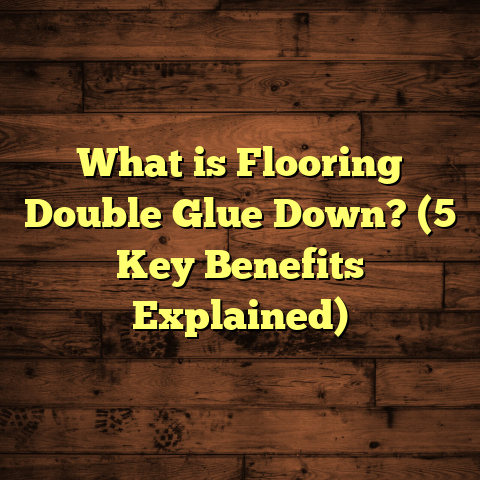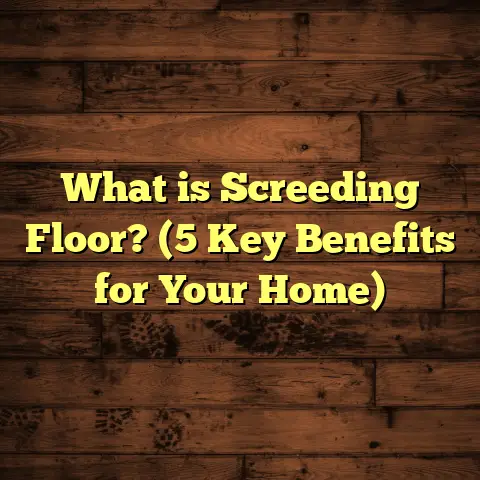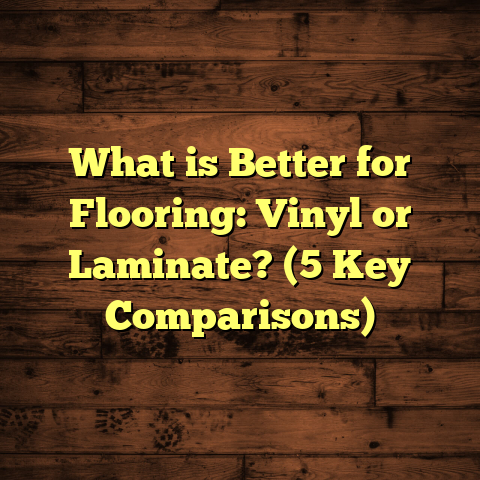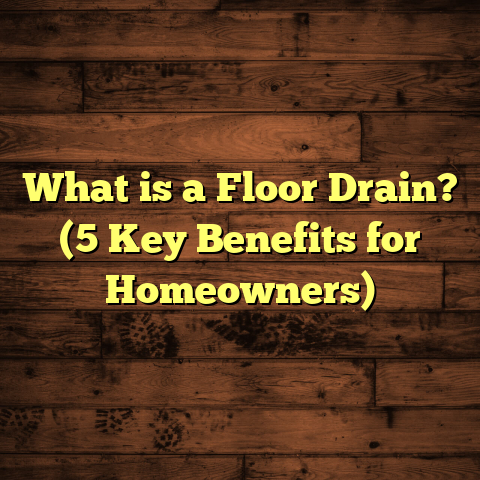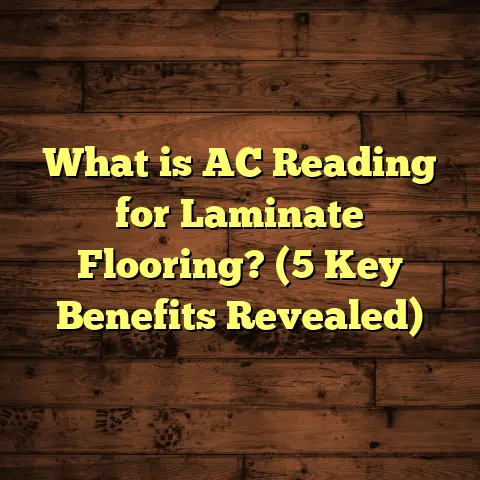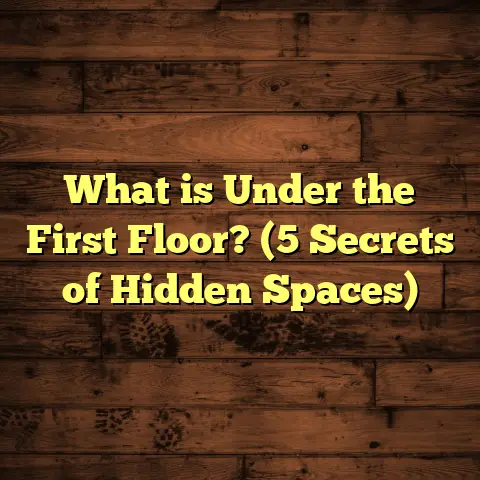What is Rubber Flooring Called? (5 Types You Didn’t Know!)
I still remember the first time I walked into a gym and noticed that thick, springy floor beneath my feet. It wasn’t wood, tile, or carpet—it felt different, safer somehow. That’s when I realized how versatile and fascinating rubber flooring really is. Over the years, as a flooring contractor, I’ve worked with all kinds of materials, but rubber flooring has its own unique charm and practical benefits that most people don’t know much about. Let me share what I’ve learned about rubber flooring—what it’s called, the types you might not have heard of, and why it might just be the perfect choice for your next project.
What Is Rubber Flooring?
Rubber flooring is exactly what it sounds like: a type of floor covering made primarily from rubber. But it’s not just one thing. It comes in various forms and styles to suit different needs, from gyms to playgrounds, hospitals to homes. At its core, rubber flooring is prized for its durability, slip resistance, shock absorption, and noise reduction.
You might be wondering: Why rubber? Well, rubber is a natural or synthetic material that offers flexibility and resilience. When used as flooring, it creates a surface that’s comfortable underfoot and can handle heavy traffic without showing wear. Plus, many rubber floors are designed to be eco-friendly, made from recycled materials like old tires.
Here’s what really stuck with me: according to industry data, rubber flooring can last 10 to 20 years with proper care—far longer than some vinyl or laminate options. And it maintains its performance even in high-moisture or heavy-use areas.
So what do people call rubber flooring? That’s where things get interesting because it goes by different names depending on its form and use.
5 Types of Rubber Flooring You Probably Didn’t Know About
1. Rubber Roll Flooring
When I first used rubber roll flooring in a commercial gym installation, I was impressed by how quickly and effectively it covered large areas. This type of rubber flooring comes in huge rolls—typically 4 to 6 feet wide—and is laid down much like carpet. It’s great for covering big spaces without seams showing.
Rubber rolls are usually 3mm to 10mm thick and can be smooth or textured. This flooring is popular in fitness centers because it’s shock-absorbent and easy to clean. It’s also economical for large spaces.
A study by the International Health, Racquet & Sportsclub Association (IHRSA) found that gyms using rubber roll floors reported 15% fewer injuries related to slips or falls compared to other surfaces.
What I love about roll flooring is how it can be customized with colors and patterns. One of my clients opted for a speckled black-green roll that hid dirt well yet brightened up their workout area. That simple choice made a huge difference in maintenance ease and aesthetics.
2. Rubber Tiles
If you want flexibility, rubber tiles are your friend. I’ve installed them in school gyms and daycare centers because they allow for easy replacement of damaged sections without tearing up the whole floor.
Tiles come in sizes like 12×12 inches or larger and are often interlocking. They can vary in thickness from 6mm up to 25mm for heavy-duty applications. The modular nature makes them perfect for DIY projects too.
One of my clients loved the fact that with tiles, she could change the color patterns anytime—something you just can’t do with rolls.
From an installation standpoint, tiles are more labor-intensive than rolls but offer significant advantages in versatility. I remember a school that had frequent spills and scuffs; replacing tiles was quick and cost-effective compared to redoing an entire floor.
3. Rubber Pavers
Have you ever seen those thick, heavy-duty squares outside playgrounds or pool decks? Those are rubber pavers. When I worked on a playground project last year, we chose these because they provide excellent cushioning against falls.
Pavers are thicker than other rubber flooring types—usually around 2 inches—and designed to absorb impact. They’re often made from recycled tires compressed into dense blocks.
According to the Consumer Product Safety Commission, playground surfaces with impact-absorbing materials like rubber pavers reduce serious injury rates by up to 70%.
Pavers are also great for outdoor use because they drain water well and don’t become slippery when wet, unlike concrete or asphalt surfaces.
4. Rubber Matting
Rubber mats are the most straightforward form of rubber flooring. You’ve probably seen them in kitchens, garages, or workshops where standing for long hours is common.
I personally use rubber mats in my workshop because they reduce fatigue and prevent slipping on oily floors. They come in rolls or individual mats with beveled edges for safety.
Matting thickness varies widely—from thin anti-fatigue mats at about 8mm to heavy industrial mats up to 30mm thick.
One memorable experience was installing anti-fatigue mats in a factory setting where workers stood for 10+ hours daily. The difference was clear immediately—less foot pain, fewer complaints about leg cramps.
5. EPDM Rubber Flooring
This one might sound technical but bear with me. EPDM stands for Ethylene Propylene Diene Monomer—essentially a synthetic rubber highly resistant to weathering and UV rays.
I recommended EPDM flooring for an outdoor sports court because it holds up well under sun exposure and changes in temperature without cracking or fading.
EPDM floors can be found as tiles or poured-in-place surfaces and are often used in both indoor and outdoor applications where durability is critical.
What’s cool about EPDM is its versatility—not only does it resist weathering but it can be mixed with color granules for bright, custom looks on running tracks or playgrounds.
Why Does Rubber Flooring Matter So Much?
You might ask: Why should I even think about rubber flooring? Here’s what I’ve seen over years of working with clients—it’s a balance of safety, longevity, comfort, and style.
Rubber floors absorb shocks better than almost any other material. This means less strain on joints when walking or exercising—a huge plus in gyms or homes with elderly people.
Data from the National Floor Safety Institute shows that slip-and-fall accidents decrease by nearly 40% when rubber flooring replaces hard surfaces like tile or concrete.
It’s also easy to maintain. Unlike carpet that traps dirt or hardwood that scratches easily, rubber floors clean up with just soap and water. That makes it ideal for busy commercial spaces.
Rubber flooring also gives off minimal VOCs (volatile organic compounds), which means better indoor air quality compared to some vinyl or laminate floors containing adhesives or plasticizers.
How Rubber Flooring Supports Sustainability
One aspect that truly surprised me was how environmentally friendly many rubber floors can be. A lot of rubber flooring products are made from recycled tires—a great way to reduce landfill waste.
For example, crumb rubber flooring uses tiny shredded bits of recycled tire rubber bound together with polyurethane binders. This process gives new life to old tires while creating durable surfaces.
In fact, the Rubber Manufacturers Association reports that over 300 million tires are recycled annually into products like flooring alone.
I once worked on a green building project where clients wanted sustainable materials throughout. Rubber flooring made from recycled content fit perfectly into their LEED certification goals.
My Experience Installing Rubber Floors
Let me tell you about a project that really opened my eyes to how versatile rubber flooring can be. A local community center wanted new floors for their gym and multipurpose rooms. They needed something durable but budget-friendly.
We decided on rubber roll flooring for the gym because of its cushioning and ease of installation. For the multipurpose rooms, we used colorful rubber tiles to brighten up the space.
The feedback was incredible—users noticed less noise echoing during basketball games and kids felt safer while running around. The center saved money too because maintenance costs dropped significantly compared to old hardwood floors.
Another story comes from a client who wanted anti-slip mats installed in his restaurant kitchen after several near-accidents on greasy floors. The mats reduced slips by more than half within the first month—a real lifesaver!
How To Choose The Right Rubber Flooring For Your Space
Here’s a little secret: choosing the right type depends on your specific needs—traffic volume, budget, comfort level desired, and aesthetics all play a role.
Ask yourself questions like:
- Will this be indoors or outdoors?
- Is impact absorption important? Are kids or elderly involved?
- Do I want a seamless look or modular options?
- How much maintenance am I willing to do?
- Are you concerned about eco-friendliness?
For example, heavy commercial gyms often prefer rubber rolls for coverage and cost efficiency. Schools or daycare centers might pick tiles because of damage replacement ease. Outdoor sports courts benefit greatly from EPDM’s weather resistance.
When I guide clients through these questions, we often find a perfect match by balancing their priorities with product features.
Rubber Flooring Cost Insights
Curious about the price? From my experience and industry data:
- Rubber roll flooring typically runs between $2.50 to $8 per square foot installed.
- Tiles average from $3 to $10 per square foot depending on thickness and quality.
- Pavers are pricier, around $10 to $20 per square foot because of their thickness.
- Matting is more affordable but varies widely based on size and thickness.
- EPDM floors often cost $6 to $15 per square foot installed due to specialized materials.
These figures include labor but can fluctuate based on location and project complexity.
Here’s an example: For a 1,000 sq ft gym floor using mid-range rubber rolls at $5 per sq ft installed, the total cost would be roughly $5,000—a solid investment for durability and safety.
Installation Tips From Someone Who’s Done It
Installing rubber flooring isn’t rocket science but doing it right makes all the difference.
For rolls:
- Measure accurately; add about 5-10% extra for waste.
- Prepare the subfloor cleanly; remove debris and smooth out bumps.
- Use recommended adhesive; many rolls come with pressure-sensitive backing too.
- Roll seams carefully with a seam roller to prevent lifting.
For tiles:
- Lay out tiles dry first to plan pattern.
- Clean subfloor thoroughly.
- Some tiles snap together; others require glue.
- Replace damaged tiles immediately to avoid spreading damage.
For pavers:
- A stable base is critical; usually compacted gravel or concrete.
- Lay pavers evenly; check level frequently.
One installation story: On a commercial gym job, we had to remove old carpet first which revealed uneven concrete slabs below. We spent extra time grinding down high spots before rolling out rubber rolls—which paid off with a smooth final surface that lasted years without issues.
Maintenance Tips That Keep Rubber Floors Looking Great
One of the best parts about rubber floors is how easy they are to maintain. From my hands-on experience:
- Sweep or vacuum regularly to remove dirt.
- Mop with warm water mixed with mild detergent.
- Avoid harsh chemicals that can degrade the surface.
- Use protective pads under heavy equipment.
- For outdoor EPDM surfaces, clean debris frequently to prevent mold growth.
- Avoid dragging heavy furniture directly across floors.
A case study from a school district showed that regular maintenance increased their rubber floor lifespan by over 5 years compared to neglected floors.
Common Issues With Rubber Flooring (And How To Fix Them)
Even though rubber floors are tough, they’re not invincible. Here’s what I’ve seen:
Issue: Curling edges on roll flooring
Fix: Often caused by improper adhesive use or moisture underlay; re-gluing edges usually works if caught early.
Issue: Stains from oils or chemicals
Fix: Clean spills immediately; use manufacturer-recommended cleaners; sometimes professional restoration needed.
Issue: Fading colors (especially outdoors)
Fix: Use UV-resistant EPDM options outdoors; avoid harsh cleaners indoors.
Issue: Indentations from heavy equipment
Fix: Use protective mats under machinery; rotate furniture occasionally if possible.
Knowing these helps clients save money on repairs down the road.
How Rubber Flooring Compares To Other Materials
I’ve installed hardwoods, laminates, vinyls—and here’s how rubber stacks up:
| Feature | Rubber | Hardwood | Vinyl | Carpet |
|---|---|---|---|---|
| Durability | Very High | Medium | Medium | Low |
| Slip Resistance | Excellent | Moderate | Moderate | Poor |
| Shock Absorption | Excellent | Low | Low | Medium |
| Maintenance | Easy | Moderate | Easy | Difficult |
| Cost (per sq ft avg) | $3-$15 | $6-$12 | $2-$7 | $1-$5 |
| Environmental Impact | Often recycled | Depends on source | Often synthetic | Synthetic fibers |
Rubber offers a unique combination: tough enough for high traffic yet soft enough for comfort—and it stays safer when wet.
The Future of Rubber Flooring
The industry keeps evolving fast. New advancements include:
- Bio-based rubbers: Derived partly from plants instead of petroleum.
- Improved binders: For stronger recycled crumb rubber tiles.
- Smart floors: Embedded sensors measuring foot traffic or impact forces.
I’m excited about how these developments may make rubber floors even more sustainable and functional going forward.
Wrapping Up My Thoughts On Rubber Flooring
Rubber flooring isn’t just “rubber.” It’s a smart choice packed with options you probably never knew existed—from rolls to pavers, mats to EPDM tiles. Whether you need safety for kids, comfort during workouts, or weather-resistant outdoor surfaces, there’s a kind of rubber flooring waiting for you.
If you’re thinking about upgrading your floors soon, consider what you really need out of them—and maybe give rubber a chance. It might surprise you how much difference it makes underfoot.
Got questions about your specific project? I’m here to help you figure out which type suits you best!
